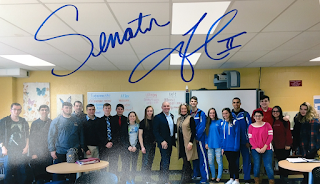Back in October, I explained extension activities to my Digital Citizenship course. These are activities, proposed by me or by them, would take the information we learned in class and extend their learning about the topic. One of my students, Rachel Meller (@rachmeller) decided that she wanted to do a Digital Citizenship Summit. I was over the moon about the prospect of bringing our message of digcit and digital leadership to a larger audience. Even though everything we do in class goes beyond our four walls and forty minutes, we wanted to hold something for our local community to share our learning and to promote more digital citizenship and digital leadership awareness.
The planning began in mid October and we reached out to Marialice Curran (@mbfxc) to see what her thoughts were and to see what guidance she could give us. This started the ball rolling and we were along for the ride! What developed over the next few months and culminated in our event was absolutely amazing!
Although I was involved in the planning, this was a student driven initiative. They planned the logistics, procured sponsors, set up the speakers, spoke with both our principal and superintendent and set the agenda for the day. I was in awe of their abilities to bring this together!
One of the best (there were actually a lot of best things) to come out of that day was a documentary called
Positively Social that was a collaboration of our video specialist from BOCES, District Media Relations Coordinator and students, staff and administration from many different school districts around the region. The outcome was a professionally made video that really highlights how we are teaching digcit and how students are leveraging social media for so many positive purposes. Everyone that has seen it, both at the event and in other venues, has raved at the insight it shows into what our students are achieving! Hope you enjoy it! Feel free to share it!
On the day of the event, our Superintendent, Jason VanFossen (@vanfossenjason) kicked the day off, introducing all of the students involved and our State Senator (@fredakshar), who visited with us for a better part of the morning. We then showed Positively Social, which then led into our Keynote Speaker Curran Dee. He is the CKO (Chief Kid Officer) of DigCitKids and an advocate for technology use in the classroom that extends the learning possibilities. He spoke very passionately that he learns differently at school than he does at home. It really hit home for the educators in the audience. By the way, did I mention he is 10 years old? Want to learn more about Curran's passion? Watch this
Tedx Talk. It is well worth the 15 minutes! So powerful to see what we are doing in the classroom from the perspective of a student!
Next we had breakout sessions where we encouraged our attendees to use the power of two feet.
Here is the plan for the day, a little bit more about our speakers and the session list.
After lunch, we had one of the most powerful parts of the day. We had two students who wanted to talk about how they have leveraged social media.
Casey Adrian (casey_adrian), Class of 2018, spoke about how he has leveraged social media to become a published author. He pointed out how accessible publishing is to all of us now and that we don't have to have a million dollars nor have connections to be published anymore. You can access his book,
Broken Euphoria, on Amazon.
Next up was Alicia Vesely (@veselyalicia), Class of 2017. She wanted to share her journey through the LGBTQ community and the support that she has received because social media allows her to access a supportive community that those before her did not have. Talking about being an upstander and how being able to reach across the state, country or globe to help someone could make the difference in that person's life.
Our last speaker of the day was Marialice Curran (@mbfxc) who spoke about why digcit is so important and why it is all of our jobs to make sure that we are not only engaging our students with use of tech in the classroom, but responsible use of it. Promoting the positive instead of block and ban will better prepare our students for their futures!
Our day concluded with a student panel where audience members could ask students about all things technology, digital citizenship and digital leadership. This was a very meaningful experience for those of us in the audience because we don't always seek out student voice in the classroom, let alone in a community setting like this.
Thank you to
Molly, 3rd grader
Curran Dee, 4th grader and Keynote Speaker
Chris Card (@cardytheparty), Class of 2017, Maine Endwell High School
Stephanie Muggeo (@stephmuggeo) Class of 2018, Maine Endwell High School
Theresa Karabon (@theresaaa104) Class of 2018, Maine Endwell High School
Casey Adrian (@casey_adrian) Class of 2018, Maine Endwell High School
Sarah Schepis (@sarahschep) Class of 2017, Maine Endwell High School
Rachel Meller (@rachmeller) Class of 2017, Maine Endwell High School
Alicia Vesely (@veselyalicia) Class of 2017, Maine Endwell High School
Overall, the day was a huge success! I am so thankful for all who were involved, all that attended and all that made the day happen. This is a testament to social media and the power of collaboration that it enables. Marialice and I have been collaborating for over 3 years but just met each other the day before our event. It was like a reunion of two people who had known each other our entire lives! I would recommend holding a summit in your community or district. It is such a transformational event! If you have questions, please feel free to reach out to me via Twitter (@MrsMurat) or email: rmurat@me.stier.org.























